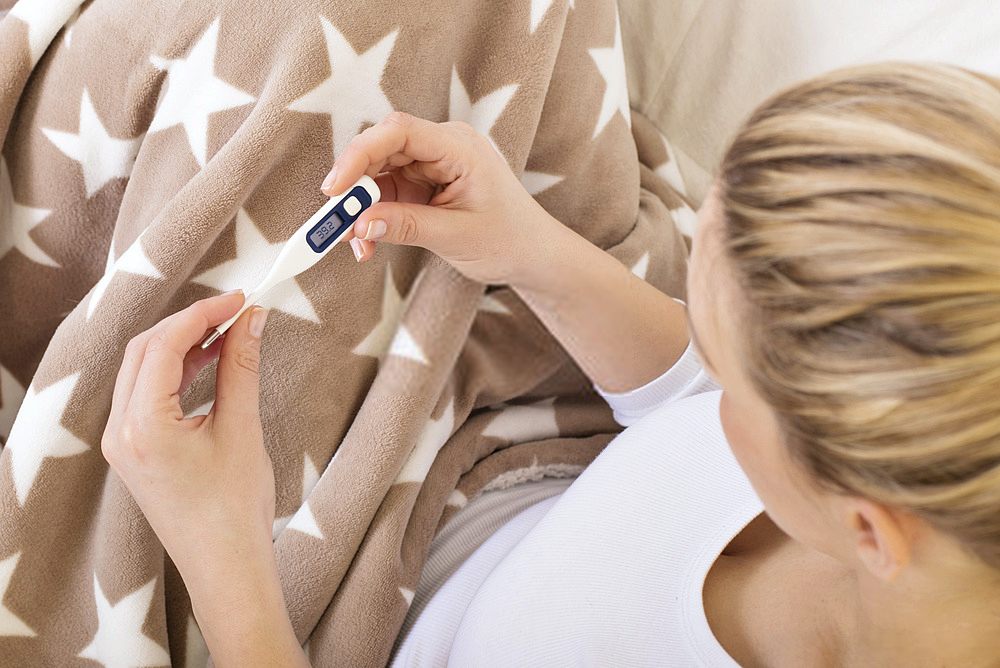Home remedies against fever help to control elevated temperatures in a gentle and natural way. With these remedies, fever can be reduced.
What’s a Fever?
When do I get a fever? In adults, a temperature of 37.5 degrees Celsius or higher is considered to be an elevated temperature, and a temperature of 38.5 degrees Celsius or higher is referred to as a fever. In older people, infants and small children, temperatures above 37.8°C are already alarming. Fever is often one of the symptoms of infectious diseases such as influenza. By the way, in this article we explain how fever measurement works.
Why Do We Get a Fever?
Fever is actually a practical tool of the body to help the immune system defend itself against pathogens: A high body temperature accelerates metabolic processes and prevents viruses and bacteria from multiplying. Therefore, an increased temperature should not be stopped immediately.
Which Home Remedies Help against Fever?
From a temperature of 39 °C it is advisable to take measures to reduce fever. Which household remedies help against fever?
1. Calf Compress
If the fever’s above 39, you should do a calf compress: Place moist small towels around the calves, wrap dry tea towels over them, on the outside with a light scarf. As soon as the wrap feels warm on the body, it should be wrung out and replaced. With calf compresses, fever can be reduced and they simply feel pleasantly cool.
2. Vinegar Stocking
Vinegar stockings are an alternative to wraps. Water and cider vinegar are mixed in a ratio of 5:1 and two cotton socks are dipped into the tincture. These are then put on over the calves at best. A pair of dry socks is pulled over them. Adults may wear the vinegar stockings for between 45 and 60 minutes, children up to 20 minutes. Then the calves are gently rubbed off.
3. Washing
The washing is especially beneficial for small children. The child is wiped with a washcloth dipped in lukewarm water. First the hands, then the arms, the neck, the stomach, the sides, the back, the feet, the legs, finally the bottom – at best in the direction of the hair growth, otherwise with circular movements. The washcloth should only be moistened. It is best not to dry the child afterwards, so that an evaporation cold can develop. Instead, the child is given dry clothing and warmly covered.
4. Drink a lot!
Above all water and sweaty tea, for example with lime blossoms or other medicinal plants (for example sage), are well suited for drinking with fever.
5. Jin Shin Jyutsu
Place the fingers of the left hand about five centimetres to the right of the spine on the edge of the pelvis and the fingers of the right hand to the right of the pubic bone. Hold for at least three minutes, or longer until a steady pulsation is felt. Then change fingers and sides. This little exercise can also be repeated several times a day.
6. Cold Baths
Warm water between 38 and 40°C also has a diaphoretic effect and lowers the fever. Three to four drops of an essential oil (e.g. peppermint) in the bathtub are also useful. A cold bath should last a maximum of 20 minutes so that the circulation is not strained. A lot of rest is especially useful after the bath: wrap it up warm and put it to bed.
When Should I See a Doctor with a Fever?
Strong feeling of illness, dizziness, shortness of breath and persistent fever above 39°C are a case for the doctor and should no longer be treated only by home remedies against fever. If the doctor does not make home visits, it is best to take a antipyretic before going to the practice.

